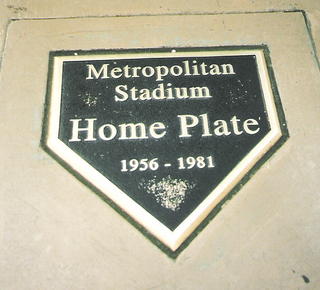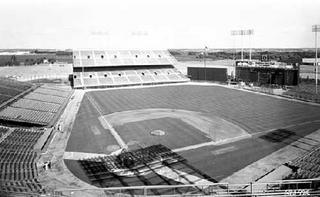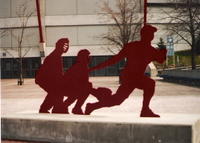 All that remains of Metropolitan Stadium, former home of the Minnesota Twins.
All that remains of Metropolitan Stadium, former home of the Minnesota Twins.
Imagine a ballpark so bad that a domed, plastic-grassed multipurpose barn was an improvement.
Picture a ballpark so woebegone that tearing it down and replacing it with a mall was actually a pretty good idea.
We can only be talking about Metropolitan Stadium, home to the Minnesota Twins from 1961 to 1981.
I was visiting Minneapolis for an education writers conference in 1996, and used some free time to wander over to the Hubert H. Humphrey Metrodome. The Twins were on the road, but I was hoping to check out a gift shop.
I got even luckier.
I walked in and an employee asked "Are you here for the tour?"
"Why yes. Yes, I am," I replied, thinking quickly.
"They just started." the employee said. "You can catch up with them."
Sure enough, a group of kids — they might have been Cub Scouts — was there on some kind of field trip. I think the other dads thought I was a chaperoning parent who they hadn’t met yet. I tagged along in the rear of the group. No one asked who I was, and I didn’t volunteer information other than some small talk like, "Hey, they kids sure are enjoying the tour. This was a good idea." A good adventure always has risk.
 The Hubert Humphrey Metrodome, not the nicest-looking ballpark.
The Hubert Humphrey Metrodome, not the nicest-looking ballpark.
We walked through some of the luxury boxes and some of the service corridors. The clubhouses were off-limits, but we were able to go out on to the field.
A college football team was practicing down one end of the turf, but we were allowed to wander around right field. Some of the kids and I had fun pretending to make Kirby Puckett-esque catches against the "Hefty bag" that serves as the outfield wall. A massive Dodge ad seemed to stretch from the foul pole all the way to centerfield.
I was struck by just how cavernous the place was. The team made some half-hearted attempts to dress it up with some banners of players hanging along the roof. And there was no hiding it’s multi-purpose-ness.
It didn’t seem like it was a particularly nice place to see or play a game, though there’s no denying the Twins have enjoyed some success there.
Of course, after reading about where the Twins used to play, the Metrodome seemed like paradise.
Metropolitan Stadium was built for the Minneapolis Millers of the minor leagues in 1956, but it was clear it was intended to lure a Major League team. It had a curved, triple-decker grandstand stretching from first base to third, and some temporary bleachers.
The Washington Senators arrived and were renamed the Twins in time for the 1961 season, and the first and second decks of the grandstand on the first base side were extended down the left field line. But for some reason, only better bleachers were added along the right field line, creating what I’m assuming were some horrible sight lines.
What was already a hodgepodge became even worse when the Vikings football team added a double-decked pavilion in left field, kind of an early version of the disaster in Oakland where the Athletics and Raiders share a stadium.
Given all these issues, it wasn’t long before there was talk of leveling the stadium, with the usual debate about who would be picking up the tab. Apparently maintenance was scaled back to accelerate the pace, and it got so bad that in the ballpark’s final season the third deck was considered a safety hazard because of broken railings.

But a bad setting doesn’t always make for bad baseball. The Twins went to the World Series in 1965 and took the division crown in 1969 and 1970. Zolio Versalles earned an MVP and Jim Perry a Cy Young. Hall-of-Famers Harmon Killebrew and Rod Carew played at the Met, along with Jim Kaat, Tony Oliva and Bert Blyleven, players who still get strong Cooperstown consideration.
Metropolitan Stadium was leveled in the early 1980s to make way for the Mall of America, which I learned is only a $1 bus ride away from downtown Minneapolis. I had some time after to conference ended and caught the bus, curious to see if anything remained of the stadium.
The mall itself is not especially exciting. It’s pretty much the same stores you see in every other mall — just more of them — with a small theme park in the middle.
A Camp Snoopy employee pointed me to a plaque in the floor that rests in the approximate location of home plate.
And high on a wall sits a stadium seat — with no way to get to it. That’s the spot where Killebrew hit the longest home run in Metropolitan Stadium history, a 520-foot blast on June 3, 1967.
In Other Words...
There are two Web sites, www.ballparks.com and www.ballparkwatch.com that I find to be awesome resources for stadium histories.




1 comment:
really enjoyed it. Thanks!
Post a Comment